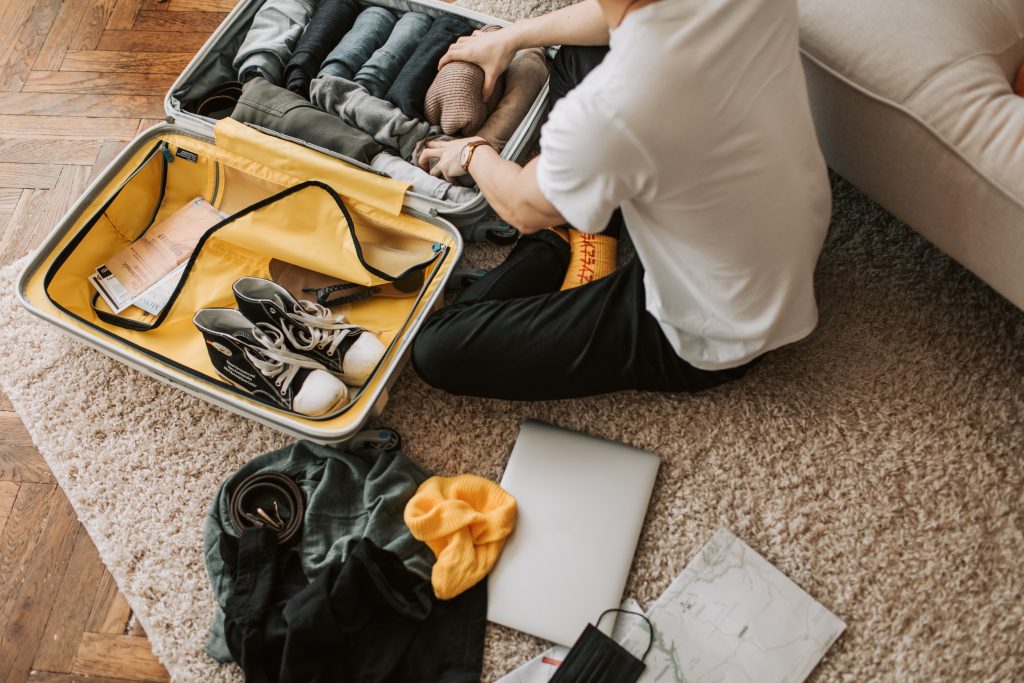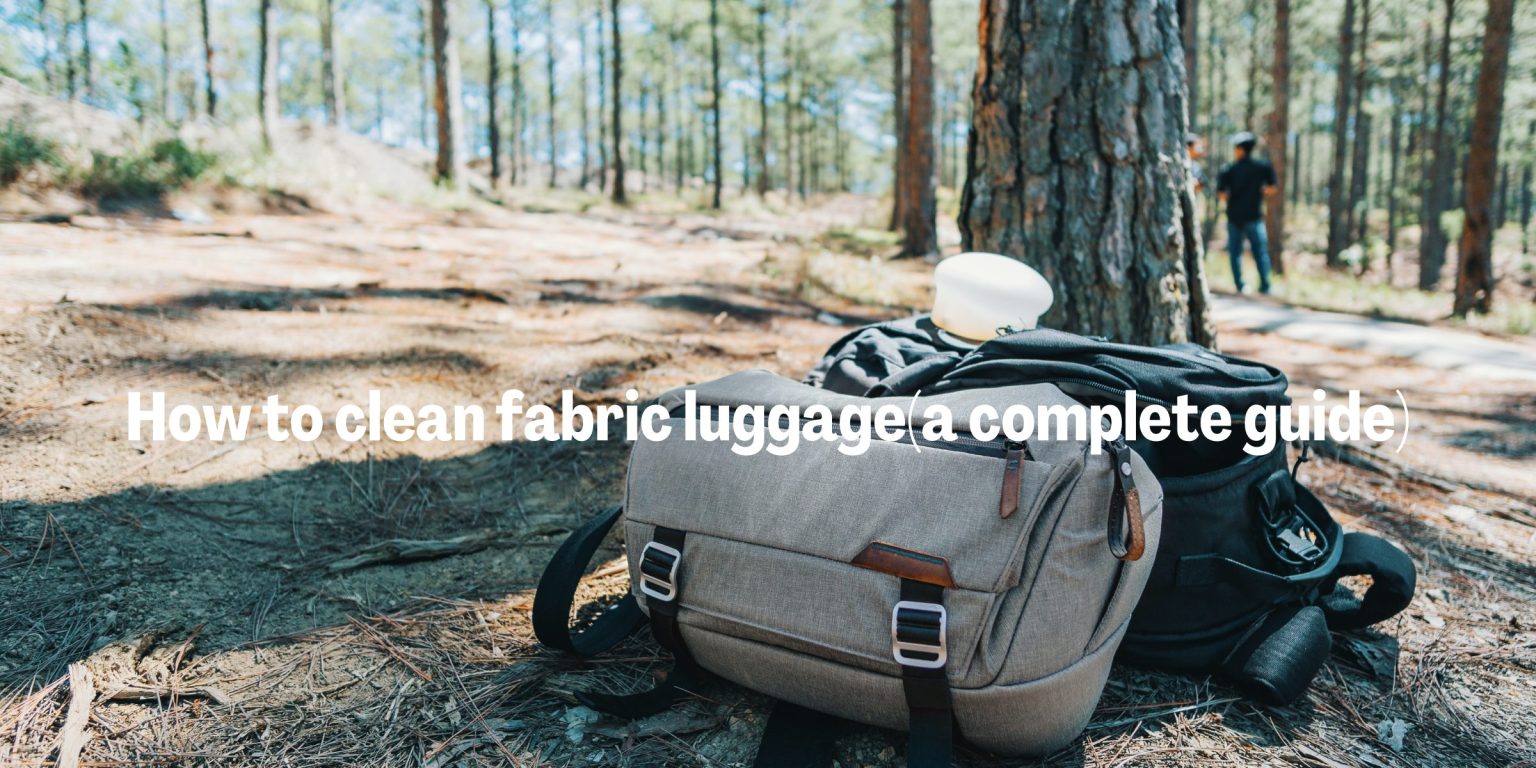The best travel companion is luggage, but it can also attract dirt. Your luggage may become soiled from being moved around the airport frequently or kept at home for extended periods, even when you are away. When we consider traveling, safety and how to clean fabric luggage are the first things that come to mind. The coronavirus outbreak has undoubtedly added a long-dreaded task to our travel to-do list: effectively cleaning and sanitizing the luggage!
Clean the dirtiest luggage
Your trusty luggage can suffer wear and tear while traveling. When your luggage gets dirty, learn how to clean fabric luggage, a backpack, and other travel necessities.
Your luggage will now experience a completely different side of your trip, including dusty floors, grease on the luggage belts at the airport, and other things, whether you are traveling by train, bus, airplane, or car. It is, therefore, even more, crucial to thoroughly clean your luggage before storing it at home.
Mold is widespread in the environment and is present everywhere. Mold spores survive outdoors by feeding on decomposing organic debris, such as dead leaves and downed trees. In the natural world, mold is a necessary and helpful organism.
How to clean fabric luggage
Before storing it, knowing how to clean fabric luggage and sterilize luggage will help you avoid inviting intruders who might later cause problems for you; only those interested in learning how to clean your bag thoroughly should read this tutorial. Check out our complete suitcase repair guide to know what to do if something on your baggage is broken and you want to mend it.
Unpack and clean your clothes before cleaning your suitcase

Unpack in the garage, then throw your clothing right into the washer. This is simple if you have your clothes organized using packing cubes. Instead of leaving your dirty clothes on the floor to wash later, put them right into the washer. They should be washed in warm water with a full cycle. When your garments are finished, you want them to be free of bugs and viruses.
You can put your packing cubes right into a basin filled with warm water and a non-detergent soap (powdered soap is normally non-detergent) and give each one a thorough wash and rinse if they appear or feel dirty or if you believe you may have come into contact with bed bugs. To dry, hang them up. Put your packing cubes back into quarantine (for at least 24 hours) in the garage with your suitcases if you aren’t going to clean them.
Taking Care of Hardside Luggage

When cleaning your hard side case, you have two choices. The first step is to wash everything with a plain soap and water solution. To avoid leaving soapy stains, you should repeat the procedure with plain water. Utilizing a spray cleaner for luggage is another choice. Before using a moist towel to remove any leftover residue, wipe the product with a dry cloth first. Always be sure to completely dry your luggage before storing it.
Cleaning erasers, light abrasive cleaners, or even toothpaste might be useful in eliminating scuff marks and scratches, though you should perform a patch test first to avoid scratching your luggage. To get rid of any remaining product, wipe the area with a damp towel once more.
Cleaning the wheels and handles
Make sure your wheels are free of debris like gravel, hair, rope, or mud so your luggage can travel easily. Excessive garbage might also harm your luggage and hasten its deterioration. Because your luggage has been touched by many people and has spent a lot of time on a filthy floor, disinfectant wipes or microfiber cloths sprayed with an all-purpose cleaner should be used how to clean fabric luggage, the wheels and handles.
Clean the Wheels and Handle
Use a tissue and some hand sanitizer to thoroughly clean your suitcase’s plastic handles, linings, and wheels to prevent the spread of any potential germs.
Pristine latches and zippers
It would help if you properly know how to clean fabric luggage zippers and other hardware. Wipe the hardware with a cloth dipped in a bowl of soapy water. Dry it off with a different clean cloth or let it air dry.
How to clean fabric luggage interior(How to clean fabric luggage)
Remove everything
Remove all items from the bag before cleaning the fabric luggage. Detach the removable pockets as well. Cleaning will be simple if all of the bag’s contents are removed. Open the travel bag’s zipper and give it a good shake. This will assist in removing any loose materials from the pack.
Vacuum the bag
Vacuuming the bag is the next crucial step after taking everything out. Dust and other bigger debris that have adhered to the nylon bag can be removed by cleaning the nylon bag. Any other typical vacuum can work well, but a hand vacuum is strongly advised. Vacuum the pockets inside and out.
Make the removable pockets clean
As directed by the manufacturer, wash the pockets or liners. For instance, if the manufacturer tag for the bag specifies that it is machine washable, you can throw it in your washing machine and clean it by the manufacturer’s recommendations.
Pour warm water and a small amount of the suggested laundry detergent into the bucket if the manufacturer has instructed that pockets should be hand-washed. All bags should be completely cleaned before being hung outside to air dry.
Sanitize the nylon lining
With water and detergent, wash the nylon lining. To clean the nylon, use a wet washcloth and washing detergent. Be aware that the nylon fabric is quite delicate. So be sure to use a soft washcloth and clean it gently. Use baking soda and water on stubborn stains that a moderate laundry detergent cannot remove with an old toothbrush.
Superb hard plastic linings
The stiff plastic inner of most people’s nylon baggage bags goes unclaimed. This component is easily cleaned with moderate laundry detergent and a soft cloth. When you are through washing, quickly pat the travel bag dry with a dry towel. This will lessen the likelihood how to clean fabric luggage.
How to clean fabric luggage?
Give your suitcase a vigorous shake to get rid of the larger debris
- Get your cleaning product ready. This technique works with fabric and textile cleaning that produces foam upon application. You can use foamy carpet cleaners, upholstery, and cleansers for car seats.
- Spray the foaming spray all over your baggage until it turns white. (Use more foam than shown in the photo above because the foam sank as I took the image.)
- With a brush, work the foam into the surface, paying special attention to any obvious dirt stains.
- Use a wet/dry vacuum cleaner to remove all of the foam after 5–15 minutes, depending on your product.
- For the fixes that didn’t release, repeat the procedure. If you still can’t remove it even after the second clean, it’s likely a greasy spot that requires special attention. Advice on how to remove grease from luggage is provided lower down in the text.
- Utilizing a rag and soapy water, clean all of the plastic components.
- Keep all the zippers open and place your luggage in a well-ventilated area, preferably in the sun, to dry for a time.
Home care Remedies(How to clean fabric luggage)
Use baking soda and vinegar
When three essential nutrient sources are present, such as a consistent moisture supply, organic materials, and darkness, mold can develop on household items. As a result, a bag or suitcase that has been wet in the rain and put at the back of the closet is prone to develop a mold problem.
Yes, you can clean your nylon luggage using vinegar and baking soda. They are quite good at removing stubborn stains that ordinary washing detergent cannot. The easy actions to take how to clean fabric luggage by utilizing vinegar or baking soda are listed below.
Use an old toothbrush to smear the dry baking soda on the nylon bag. Baking soda will eliminate bacteria, remove grime, and eliminate offensive odors. vacuum the entire nylon suitcase to eliminate baking soda, dirt, debris, and dust.
Water and vinegar should be mixed in a 1:2 ratio before carefully applying them to vinegar luggage. Apply the vinegar to the nylon baggage, wetting it as you go. Give it a few minutes to sit.
Apply a solution of alcohol
Before starting the mold removal, remove everything from the bag or suitcase. Most likely, the interior of the bag or suitcase will be covered in mold spores. Turn the handbag inside out, so mold growth is on the outside.
One cup of denatured alcohol and water can clean leather luggage and handbags. After forming a hazy solution, a sponge or washcloth should be dampened with the liquid. Until the stains are gone, scrub away at the moldy spots.
Use the brush method
Another well-known method for cleaning mold from bags and purses is to use elbow grease. Because brushing off the mold spores will spread them into the air, this mold eradication technique must be carried out outside. Take this task out to prevent polluting the rest of the house.
Scrub any visible mold stains on the bag or baggage using a hand-held brush. A stiff broom may be used in place of bulky luggage. Place a wide piece of paper on the floor to catch the mold spores that may fall if these items cannot be taken outside for cleansing.
Disinfect your luggage
Cleaning is not the same as sanitizing. Clean your checked baggage, carry-on luggage‘s handle, side hand grips, and wheels with a disinfectant wipe with at least 60% alcohol in them. Pay attention to any high-touch places where unpleasant germs could gather. To ensure that viruses and bacteria are eliminated, ensure the surfaces are wet for at least 30 seconds and ideally a minute or more.
Aluminum case cleaning
If your bag is made of aluminum, you can treat it like a sizable piece of metal.
Purchase a cleaning made especially for aluminum, spray it on the shell, then buff it in to restore your suitcase’s former brilliance. That is all there is to it.
Also, try cleaning your baggage with the same kitchen cleaner you used to make your sink appear brand new.
Keeping the Zippers Clean
You can also spend a little extra time cleaning the zippers if you want to sell your bag or how to clean fabric luggage. Grab some water and a kitchen cleanser, then dip a cotton bud. The pullers and teeth can then be thoroughly cleaned until they sparkle again. Just be cautious not to get any cleaning agent on your suitcase’s lining or shell.
Dry clean luggage
It would help if you dried and how cleaned fabric luggage after each trip to ensure longer usage. You must, at the very least dry clean your luggage to preserve it from mildew, dust, particles, and insects. Is it possible to dry neat baggage? Well, it’s quite easy.
If you cannot dry clean your luggage, performing this service will cost between $20 and $60. They fix the leather components as necessary, clean the torn or worn-down textiles, and restore the plastic parts. As a result, if you have the cash, you can take your luggage to a dry cleaner, who will try their best to repair it.
It is important to note that many dry cleaning businesses’ websites don’t include cleaning luggage. therefore, preferable to call them first. this all comes down to mending, restoring, and cleaning your luggage when you dry clean it. It requires time.
clean luggage at home
You can handle this independently if you have experience cleaning fabric luggage at home. Just a few measures must be taken. It is essential, especially after returning from any trip.
It would help if you took good care of your luggage when you returned from your trip. The most effective and efficient solution is to dry clean your luggage.
Place your bags outdoors. Attempt to brush the entire surface gently. If necessary, wipe it off with a gentle, wet cloth. Verify that there is no dust within. It would help if you used a toothbrush to clean the zipper liner and the tight spaces that are difficult to access with a towel or clothing.
You can use a disinfectant like rubbing alcohol or hydrogen peroxide how to clean fabric luggage and dangerous bacteria, whether your baggage is made of fabric or has a hard shell.
Conclusion of “How to clean fabric luggage”
We discribed several easy ways to restore the fresh scent of your luggage, whether the problem is the smell of stale laundry from a recent trip or an unpleasant odor from years of travel.Cleaning your luggage after a trip will help eliminate hitchhiking germs and keep your travel buddy looking new. We know it’s tempting to toss your soiled clothing into the washer and conceal your suitcase till your next vacation.
ALSO READ: HOW TO PACK A TENT IN A BACKPACK

